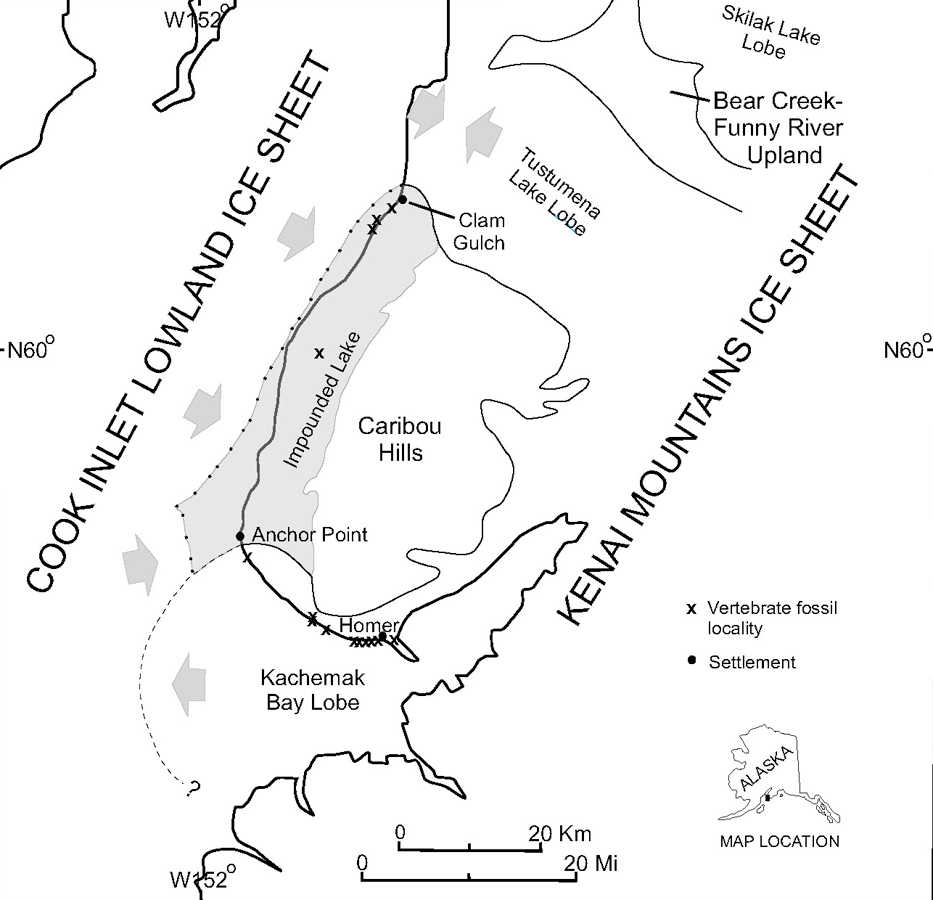In her 2008 book, “Kachemak Bay communities, their histories, their mysteries,” Janet Klein first published information about the fossils of extinct woolly mammoths found along beaches between Homer and Anchor Point. She also suggested that lay people could help us understand the presence of these mammoth fossils by contacting trained individuals or museums when they find these rare objects.
Ted Bailey followed with two 2009 Refuge Notebook articles in which he initially provided general information about extinct elephants and then discussed the climatic implications of elephant remains found along Kenai beaches. He speculated on when the extinct animals might have come onto the Kenai Peninsula but, at that time, none of the fossils had been dated. Since Ted’s articles, 10 newspaper articles and numerous public presentations by Janet Klein and me have reported our progress during a 5-year community-based investigation of these interesting fossils.
Since 1958, 19 fossils of ice-age mammals have been found on the western Kenai Peninsula. A twentieth fossil bone was too small and indistinctive to be identified or dated. In the assemblage, 17 fossils were identified to species, but only 12 samples have been dated, using funds provided by interested individuals and the investigators. Nine mammoth fossils, one steppe bison horn core, and bones of an unspeciated herbivore and an unspeciated carnivore were dated.
Samples from a mammoth molar, the horn core of a steppe bison, and a horse tibia were contaminated, and so were not dated, although they were identified and photographed. We hope to resample the only horse bone found in hopes of obtaining an uncontaminated sample.
Through the years, only photographs were available for one woolly mammoth molar, two woolly mammoth molars were lost, and two finders of a woolly mammoth molar chose not to participate in the program. Identifications were made or confirmed by Dr. Patrick Druckenmiller, an interested vertebrate paleontologist at the Museum of the North in Fairbanks.
A plot of radiocarbon ages against the glacial chronology here on the Kenai Peninsula (Figure 1) supports some of Ted Bailey’s initial speculations about when the extinct fauna probably lived on the Kenai Peninsula. Of the seven finite ages , six range from about 27,000 to 40,100 radiocarbon years before present (B.P.), and five infinite radiocarbon ages range from at least 43,500 to more than 48,500 radiocarbon years B.P., demonstrating that the animals lived here on the peninsula for at least 21,500 radiocarbon years between the last two major glaciations.
At that time, conditions in this area were probably not too different from today, except that grasslands were probably more extensive ‒ the assemblage is dominated by grazers. Evidence indicates that extinct mammals came to the peninsula from the Interior through mountain passes after the penultimate (next to last) glaciation.
We question the significance of the finite age of 20,400 radiocarbon years for an extinct elephant tusk fragment, which plots close to the climax of the last major (Naptowne) glaciation. At that time, only about 510 square miles of the highest Caribou Hills were exposed above the surrounding lowland ice sheet and the large meltwater lake that was impounded in the lowland between the western base of the Caribou Hills and the ice sheet from the west side of Cook Inlet. Almost certainly, enough vegetation to support a viable population of large herbivores did not exist in that very windy, dry, frigid, upland environment.
Our speculations that the fossils were preserved outside the limits of the Naptowne glaciation are supported by the distribution of fossil finds (Figure 2), which are concentrated in the Clam Gulch and Homer areas. The Clam Gulch fossils were found inside the limits of the old meltwater lake basin. The single find near the middle of the old lake basin was actually located on a gravel bar deposited during the massive 2002 flood of Deep Creek, and confirms the Caribou Hills as the source of that 31,740-RC-year-old extinct elephant tusk fragment. The Homer samples, while technically in the glaciated area, were likely moved from the sites of their initial preservation to localities where the fossils were recovered during floods, by longshore currents along Cook Inlet beaches, or were carried by debris flows.
Fossils recovered and identified on the Kenai Peninsula so far represent the three mammal fossils of this age typically found in interior Alaska: steppe bison (most common), mammoth, and horse (least common). Potentially, other mammals that could have provided bones in a very diverse assemblage include mastodon (another extinct elephant), muskoxen, caribou, sheep, elk, moose, a moose-elk, yak, saiga antelope, wolves, foxes, short-faced bear, brown bear, steppe lion, saber-tooth cat, giant ground sloth, wolverine, badger, and a host of smaller mammals, like ground squirrels, lemmings, voles, shrews, ferrets, and weasels. Many of these mammals are extinct, but some survived the monumental environmental changes that occurred in Alaska at the end of the last major glaciation.
I encourage you to report your suspected finds to Janet Klein in Homer (907-235-8925), who is the primary contact for folks finding mammal fossils in the southwestern Kenai Peninsula.
Dr. Dick Reger graduated from Kenai Territorial High School in 1957, and eventually earned a PhD in geology from Arizona State University. Over the last 38 years, he has intermittently studied the landscape evolution of the Kenai Peninsula. You can find more information about the Kenai National Wildlife Refuge at http://kenai.fws.gov or http://www.facebook.com/kenainationalwildliferefuge.

